38 AI Statistics for 2025: Growth, Usage & Adoption
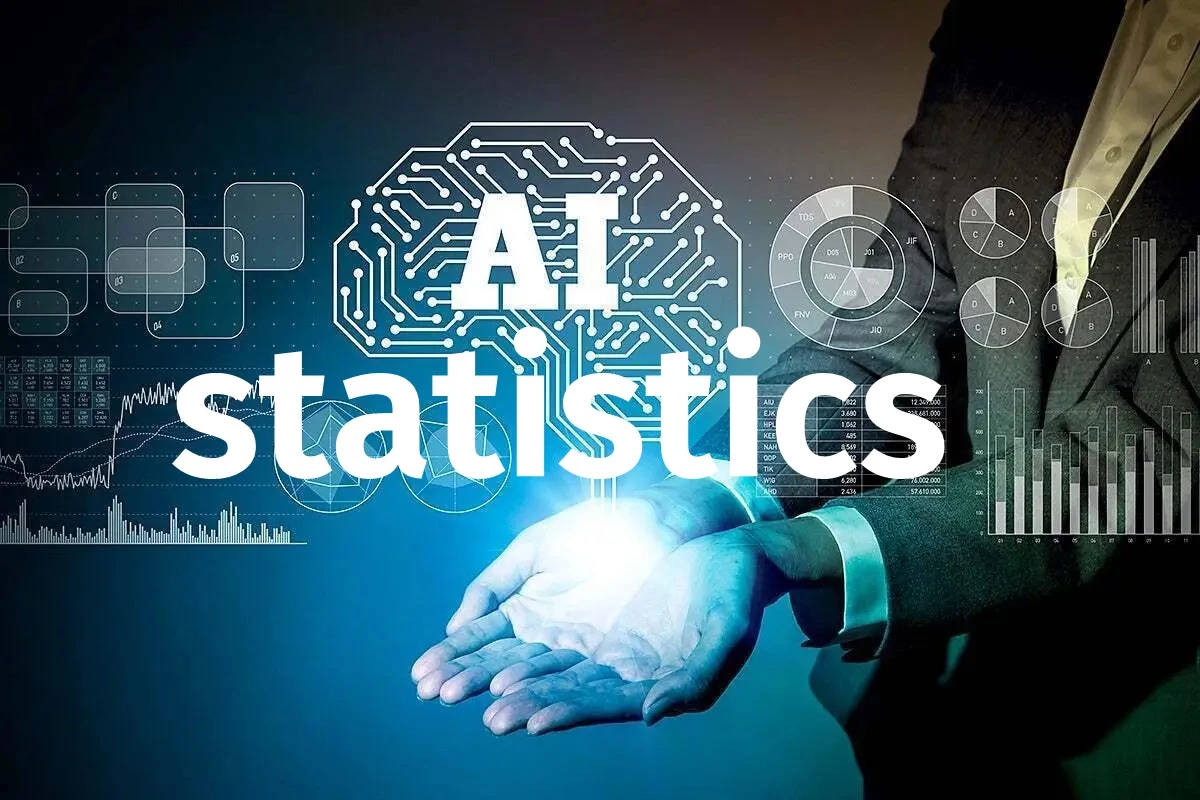
Outside of science fiction, many of us first heard about AI with the release of popular generative AI tools like ChatGPT. While these are a huge part of AI’s growth, it has been adopted by many industries and goes far beyond chatbots.
These AI statistics look more closely at the rise of the global AI market, how the technology is being applied, and what to expect in the future.
Key AI Statistics Everyone Should Know
Think you know a lot about AI? These key stats put everything into perspective.
- Between 50% and 60% of all organizations are using AI.
- The global artificial intelligence market is valued at $136.55 billion.
- AI automation could replace 300 million existing human jobs.
- Generative AI software is expected to be worth $3.7 billion by the end of 2023.
- By 2030, the global AI market is expected to reach $1.81 trillion.
AI Adoption and Usage Statistics
The following AI statistics look at the rate of adoption as a whole and in specific industries.
1. Between 50% and 60% of all organizations are using AI.
(Source: McKinsey)

AI adoption has skyrocketed in recent years, more than doubling since 2017. However, between 2019 and 2022, adoption is leveling out at between 50% and 60%.
Between 2018 and 2022, digital budgets went from 40% going towards AI to 52%.
2. 77% of businesses have already adopted AI or have an adoption plan.
(Source: IBM)
It is businesses more than individuals that are leading the charge in AI. 35% of businesses have already started using some form of AI, while 42% are planning to adopt it in the near future. This has given rise to fears that human roles will partly or fully be replaced by AI systems.
3. AI is most heavily used within ‘service operations’ and ‘strategy & corporate finance’.
(Source: Statista – AI by Industry)
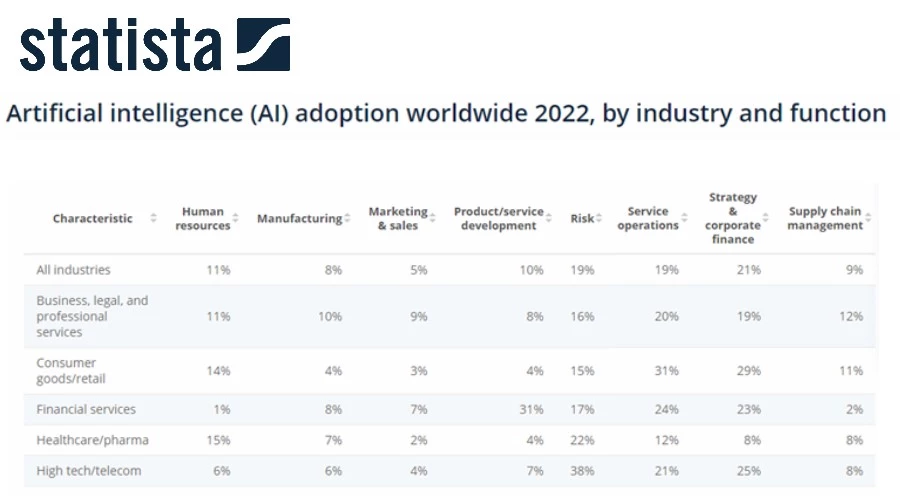
In 2022, AI was used the most for service operations (customer service) and strategy & corporate finance (mapping out the future of a company and its finances). Of almost all industries that use AI, 20% of usage was applied to these two business functions.
The financial services industry stood out the most for using AI to develop new products and services, with 31% of respondents using it this way.
4. An average of 3.8 different AI capabilities are being used by organizations that have adopted AI.
(Source: McKinsey)
As of 2022, adopters of AI have embedded an average of 3.8 AI capabilities within their organizations. This is up from 1.9 capabilities in 2018 but down 0.1 from 2021.
The most common application is robotic process automation. This is a technical way to describe digital automation and does not refer literally to robots.
5. Every 1 in 3 college students are using generative AI like ChatGPT to do their homework.
(Source: Intelligent.com)
ChatGPT’s human language models make it perfect for crafting essays and answering questions. Research suggests as high as 30% of US college students have used the tool for homework. 60% of those students rely on AI to complete more than half of all college work.
6. 19% of healthcare organizations are already using some form of AI.
(Source: Statista – AI Adoption)
The healthcare industry is at the forefront of many AI technologies, with around a fifth of organizations already having used it for at least 2 years. Another 18% are in the process of adopting AI.
7. IT and Telecommunications use machine learning more than any other industry.
(Source: Fortune Business Insights)
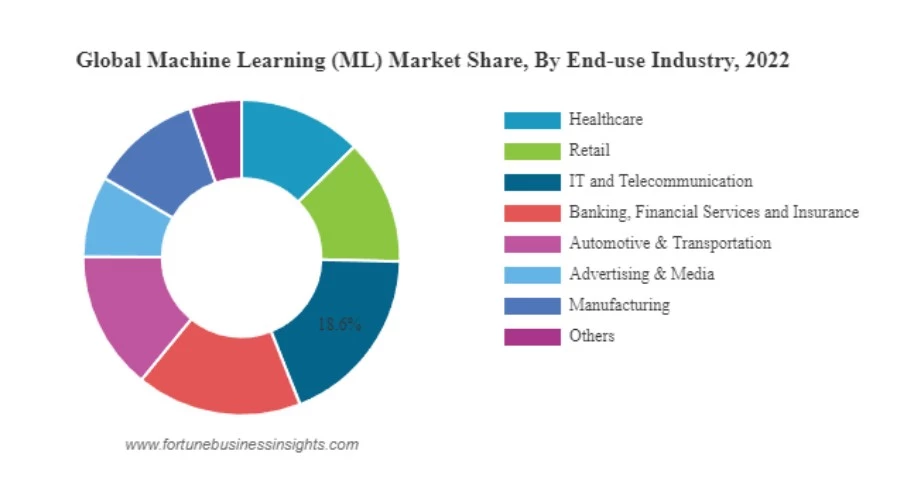
Machine learning is a key subset of artificial intelligence. It involves training a system on a large dataset to recognize patterns and extract insights from the data.
Currently, the IT and Telecoms industry has an 18.6% share of the market. The financial industry, auto industry, retail, and healthcare all have significant investments in machine learning too.
8. More than half of telecommunications organizations use chatbots
(Sources: Gartner, Accenture)
Public-facing chatbots are revolutionizing the way customer support is delivered. It allows for out-of-hours problem-solving and reduces reliance on low-skilled support staff. Telecoms businesses are leading the charge, with 52% already using AI chat support bots.
Despite this, only 7% of people trust chatbots when making a claim.
9. 55% of Americans say they interact with AI at least once a day.
(Source: Pew Research)
A survey of more than 11,000 US adults found 55% encounter AI in some form at least once a day. 27% of these respondents interact with AI more than once a day. This includes AI wearables, chatbots, personalized online shopping recommendations, and other common uses.
10. Half of US smartphone users use AI voice search features every day.
(Source: Forbes – AI Stats)
Another way AI is being adopted in everyday life is through our mobile devices. Roughly 50% of US mobile users turn to their device’s voice search feature each day, which uses AI to recognize the owner’s voice commands and pull data from the internet.
11. 50% of organizations using AI are benefitting from automated IT, business or network processes.
(Source: IBM)
Of those that are benefitting, 54% are seeing cost savings and efficiencies, 54% are seeing improvements in IT or network performance, and 48% are delivering better experiences for customers.
12. Easier accessibility is the main driver behind AI adoption
(Source: IBM)
Of the top 10 factors driving AI adoption among businesses, easier accessibility is the most important (43%). This is followed by the need to cut costs and automate processes (42%). The least important factor was environmental pressure (20%).
13. Lack of AI skills among businesses is slowing AI adoption.
(Source: IBM)
The main barrier for businesses that have yet to adopt AI is a lack of expertise in how the technology works (34%). This foreshadows a rise in AI expert roles that will be tasked with onboarding and collaborating with AI.
Currently, IT professionals are the most likely to be the ones using AI within their organizations (54%), with data engineers following (35%).
As well as a lack of experts, not using AI it is about the cost of implementation (29%). This is likely to correct itself as the technology becomes more widespread and the price comes down. Moreover, AI itself saves businesses money further down the line.
14. The United States ranks number 1 on the Global AI Index.
(Source: Tortoise Media)
The United States ranks number 1 on the Global AI Index, followed by China, Singapore, the United Kingdom, and Canada.
This ranks countries based on their investment in AI, innovation, implementation, and other important markers. Kenya is at the bottom of the 62-country list.
15. AI automation could replace 300 million existing human jobs.
(Source: Goldman Sachs)
Because it can replace repetitive administrative tasks and handle vast quantities of data more efficiently than humans, it has been predicted that AI could replace 300 million existing human roles. This equates to 25% of all job tasks in Europe and the United States.
While this would still require some human collaboration and would actually increase GDP by approximately 7% due to more productivity, experts believe there will be a significant period of job instability.
16. 80% of US workers will lose at least 10% of their daily tasks to AI.
(Source: OpenAI)
OpenAI, the company behind the popular ChatGPT technology predicts that 80% of the US workforce will be impacted by AI by at least 10%. Only a select 19% of automation-prone workers will see half or more of their day-to-day tasks replaced by AI.
In other words, nearly everyone will be affected a little, while some people’s whole jobs will change or be replaced.
AI Market Share and Growth Statistics
How valuable is AI, what is the technology’s growth rate, and which countries and sectors stand out? The following statistics take a closer look at the global AI market.
17. The global artificial intelligence market is valued at $136.55 billion.
(Source: Grand View Research)
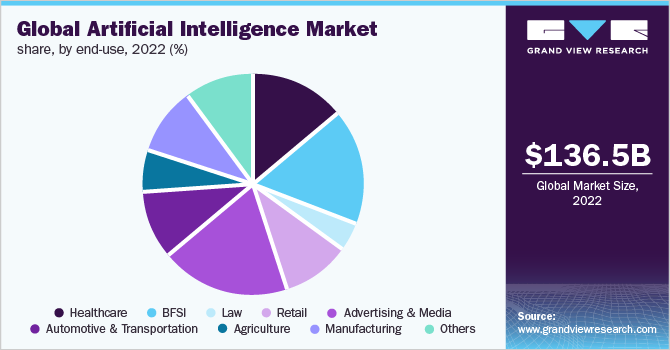
In 2022, the global AI market was valued at $136.55 billion and was led by the advertising and media segment with a 19.5% share. Other notable segments include healthcare, automotive & transportation, and others like education.
18. By 2030, the global AI market is expected to reach $1.81 trillion.
(Sources: Grand View Research, PwC)
As healthcare takes a leading role, the entire AI market is estimated at more than $1.8 trillion be the end of the decade. This represents a compound annual growth rate (CAGR) of 37.3% from 2023 to 2030 or 13 times its current value.
For the same period, AI is expected to have a total economic impact of $15.7 trillion. $6.6 trillion of this will be thanks to increased productivity, while $9.1 trillion is expected to be down to consumption-side effects.
19. North America has the highest AI market share by region.
(Source: Grand View Research)
When looking at the regional share of the AI market, North America dominated in 2022, accounting for 36.8% of global AI revenue. Meanwhile, the Asia-Pacific region is the fastest-growing market moving forward.
20. China will soon take 25% of the AI market.
(Source: Facts & Factors)
As the market leader in the Asia-Pacific region, China will account for a quarter of the global AI market by 2030, Growing at a CAGR of 39.1%. Its share will be worth $40.6 billion by 2026.
21. There was a 4% increase in the number of businesses adopting AI in 2022.
(Source: IBM)
In 2022, approximately 35% of businesses adopted AI, which is a growth of 4% from 2021. The growth rate is expected to be even larger by the end of 2023.
22. AI will have the biggest economic impact on the United States.
(Source: Accenture)
At baseline, the United States has a 2.6 Gross Value Added (GVA) rate by 2035. With the adoption of AI, this is estimated to jump to 4.6. This rate of the economic impact of AI is only seen in one other country, Finland, which is expected to go from 2.1 to 4.1 GVA with the adoption of AI.
23. AI will have the biggest impact on labor productivity in Sweden.
(Source: Accenture)
AI is estimated to boost labor productivity in Sweden by 37% by 2035. This is followed by Finland (36%), the United States (35%), and Japan (34%). Spain will experience the least boost in labor productivity from AI, estimated at just 11%.
24. Generative AI software is expected to be worth $3.7 billion by the end of 2023.
(Source: S&P Global)
Although there are many different types of AI technology, generative AI that can produce human-like content is currently making all the headlines. The popularity of ChatGPT has inspired hundreds of new startups and a competitive marketplace worth $3.7 billion by the end of the year.
Based on 263 generative AI software companies, the market is expected to reach $36 billion by 2028. This is a CAGR of 58%.
25. Code generators are the fastest-growing generative AI tools.
(Source: S&P Global)
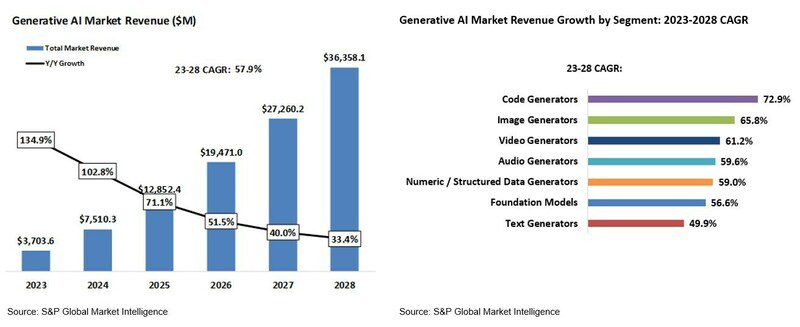
Although text generators are currently the most popular generative AI tool, it is the code generator segment that’s set to grow the fastest through the next 5 years. Its compound annual growth rate is 72.9%.
The second fastest-growing segment is AI image generators, with a 65.8% CAGR.
26. AI art generator Stable Diffusion is valued at more than $1 billion.
(Source: Forbes – Stable Diffusion, iNews)
Generative AI can create works of art not just text. With more than 10 million daily users, Stable Diffusion is valued at more than $1 billion. It is currently the leading technology outside of OpenAI’s own DALL-E art generator
It’s difficult to put a value on the AI art market, but individual pieces have sold for hundreds of thousands, and the highest-valued AI-generated NFT sold for $1.1 million.
27. The market value of AI in education is expected to hit $20 billion by 2027.
(Source: Global Market Insights)

From AI tutoring and automated grading systems to digital courses and AI learning management systems, AI in education is expected to become a $20 billion industry by 2027.
28. AI in healthcare is predicted to be worth $187.95 billion by 2030.
(Source: Statista)
From more efficiently diagnosing patients to speeding along new drug research and clinical trials, AI in the healthcare industry is expected to be valued at almost $188 billion by 2030. That’s a compound growth rate of 37% from when it was last valued at $11 billion in 2021.
29. AI will contribute an extra $3.78 trillion to the manufacturing industry.
(Source: Accenture)
Of all industries, AI is estimated to contribute the most in terms of gross value to the manufacturing industry.
Based on a non-AI trajectory, manufacturing will be valued at around $8 trillion by 2033. With AI, this is closer to $12 trillion.
30. The Machine Learning market is expected to reach $225.91 billion by 20230.
(Source: Fortune Business Insights)
By automating the analysis of large amounts of data, organizations that use machine learning AI are able to gain an advantage over their competitors.
As of 2022, machine learning technology was valued at $19.20 billion and is expected to grow to $26.03 billion by the end of 2023. The United States has the largest share by region, representing $6.12 billion in 2022.
With a CAGR of 36.2%, the machine-learning market is estimated to reach $225.91 billion by 2030.
Attitudes About AI Statistics
This data reveals the public’s perception of AI, user demographics, and other interesting stats.
31. Nearly all business owners believe ChatGPT will be a benefit.
(Source: Forbes – AI Business)
97% of 600 surveyed business owners believe ChatGPT will help their business, while 64% specified ‘improving customer relationships’ as a key benefit.
32. 38% of Americans are more concerned than excited about the rise of AI.
(Source: Pew Research)
Survey data reveals apprehension about AI among US adults, with 38% saying they are more concerned than excited about the technology. 46% were neither concerned nor excited, while only 15% are excited about the rise of AI.
33. Most organizations haven’t fine-tuned their AI to be ‘trustworthy’.
(Source: IBM)
Public apprehension around AI may be justified when 74% of organizations have not made efforts to reduce bias in their AI systems. 68% do not track performance variations and model drift, and 61% do not ensure they can even explain the decisions made by their AI.
34. 78% of Americans are concerned that AI could be used for malicious intent.
(Source: MITRE-Harris)
AI getting into the wrong hands is one thing, but 52% of poll respondents do not believe AI is safe and secure in the first place.
This might explain why 82% of the general public and 91% of tech experts want government regulation of AI. Moreover, 70% of the general public and 92% of tech experts want the industry to increase investment in AI assurance measures to protect and win over the public.
35. 75% of Americans are concerned about deepfakes and misleading AI-generated content.
(Source: MITRE-Harris)
Another concern is that the quality of AI-generated imagery and audio is getting better by the day and it might soon be indistinguishable from the real thing.
This will make it much more difficult to verify content on social media and is leading to fear about ‘deepfakes’. I.e., content that appears to come from a real person but is actually AI-generated.
36. The UK public is most concerned about AI driverless cars and autonomous weapons.
(Source: Ada Lovelace Institute)
A survey of 4,000 people in the UK found 72% are most concerned about advanced robotics such as driverless cars, while 71% are concerned about AI being used to develop autonomous weapons.
Moreover, 61% are concerned about AI-targeted advertising and 60% are concerned about targeted political advertising.
37. 90% support AI in detecting the risk of cancer.
(Source: Ada Lovelace Institute)
On the other hand, some uses are seen as very positive. 9 in 10 survey respondents said using AI for detecting the risk of cancer is beneficial.
Around 70% think AI facial recognition at border control, which speeds up processing, is beneficial.
AI robotic vacuum cleaners were not considered concerning by 88% of respondents.
38. AI experts are mostly white men.
(Source: McKinsey)
Of organizations that have adopted AI or are currently implementing it, only 27% of employees tasked with developing the AI solution are women. Only 25% are racial or ethnic minorities.
Conclusion
These fascinating AI statistics show that AI is already a massive market that will grow exponentially over the next decade.
While there are some general concerns among the public and fears of AI job losses, there are also some undeniable positives when it comes to productivity.
Sources
- McKinsey
- IBM
- Statista – AI by Industry
- Intelligent.com
- Statista – AI Adoption
- Fortune Business Insights
- Gartner
- Accenture
- Pew Research
- Forbes – AI Stats
- Tortoise Media
- Goldman Sachs
- OpenAI
- Grand View Research
- PwC
- Facts & Factors
- S&P Global
- Forbes – Stable Diffusion
- iNews
- Global Market Insights
- Forbes – AI Business
- MITRE-Harris
- Ada Lovelace Institute
Read our disclosure page to find out how can you help MSPoweruser sustain the editorial team Read more




User forum
0 messages